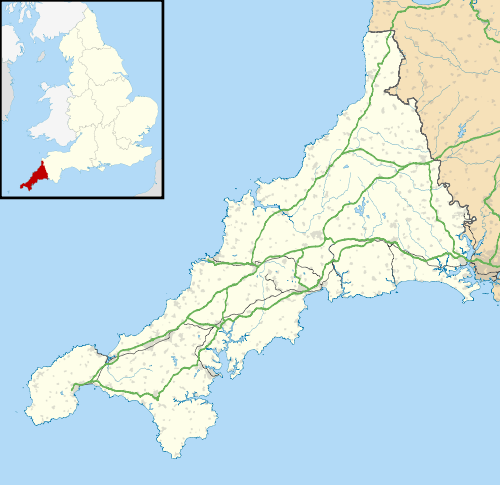St Winnow
| St Winnow | |
| Cornish: Sen Gwynnek | |
| St Winnow Parish Church |
|
 St Winnow |
|
| Population | 328 (Civil Parish, 2011) |
|---|---|
| OS grid reference | SX1157 |
| Civil parish | St Winnow |
| Unitary authority | Cornwall Council |
| Ceremonial county | Cornwall |
| Region | South West |
| Country | England |
| Sovereign state | United Kingdom |
| Post town | LOSTWITHIEL |
| Postcode district | PL22 |
| Dialling code | 01208 |
| Police | Devon and Cornwall |
| Fire | Cornwall |
| Ambulance | South Western |
| EU Parliament | South West England |
| UK Parliament | South East Cornwall |
Coordinates: 50°22′59″N 4°39′07″W / 50.383°N 4.652°W


St Winnow (Cornish: Sen Gwynnek[2]) is a civil parish situated in Cornwall, England, United Kingdom. Its name may be connected with either that of Saint Winnoc or Saint Winwaloe. It has a population of 304,[3] increasing to 328 at the 2011 census.[4] The church town is on the east bank of the River Fowey south of Lostwithiel. In St Winnow parish is also the Chapel of St Nectan. Part of the village of Lerryn lies within the parish. The Redlake Meadows & Hoggs Moor Site of Special Scientific Interest also lies within the parish.
History
St Winnow was recorded in the Domesday Book of 1086 as San Winnuc. In 1644-45, some ninety people from the parish died of the plague: only four were soldiers but a campaign of the Civil War was going on at the time.
Churches and chapels
Parish church
This is of Norman foundation but the present building is almost entirely of the 15th century. The rood screen survives and there is some interesting stained glass.
The church is at the riverside, next to a quay at the limit of navigation of the River Fowey. It is probably on the site of the 7th century oratory of St Winnoc. A stone church was built in the 12th century, probably cruciform in plan, and there are traces of the Norman stonework on the north side. The transept arch was reconstructed in the 13th century. About 1465 the south wall was demolished and the south aisle, arcade and roofs built. The chancel was restored by J. H. Seddon in the 19th century, retaining the 16th century east window. The west tower is of standard Cornish Perpendicular style. There is stained glass of c. 1500 in the east windows of the chancel and S aisle. The 16th century rood screen, carved with leaves and flowers, was restored by Violet Pinwell in 1907 (by Edmund H. Sedding according to Pevsner). The loft, rood and some of the south aisle screen were newly made in the restoration. The granite font, carved with angels bearing shields, is 14th century. The pulpit is of c.1600 and richly carved. There are also carved bench ends of various dates from 1485 to 1630. The monuments include one in slate to William Sawle, d. 1651.
A burial plot with Celtic-style headstones for the Vivian family occupies the north-west corner of the churchyard.
Chapels
The chapel of St Nectan is of the 13th and 15th centuries but the north aisle was added in 1825. The tower has lost its upper stages due to the Civil War (1644).[5] The medieval parish was larger and included also Boconnoc and St Bradoc: the chapels of St Nectan and St Martin's at Respryn were quasi-parochial.[6] The 14th century font from Respryn was reused at Herodsfoot.
Education

There is a primary school in St Winnow, St Winnow C E School. The majority of children aged between 11 and 16 attend Fowey Community College.
Ethy
References
- ↑ This was the site of a major battle between Cavaliers and Roundheads during the Civil War
- ↑ "Cornish Language Partnership : Place names in the SWF". Magakernow.org.uk. Retrieved 2016-10-20.
- ↑ "Check Browser Settings". Neighbourhood.statistics.gov.uk. Retrieved 2016-10-20.
- ↑ "Parish population 2011". Genuki.org.uk. Retrieved 14 February 2015.
- ↑ Pevsner (1970) Cornwall, 2nd ed. Penguin Books, pp. 196, 204-05
- ↑ Cornish Church Guide (1925) Truro: Blackford; pp. 220-221
Further reading
- Brown, H Miles. (1994) The Book of St Winnow. Liskeard: Artworks.
External links
| Wikimedia Commons has media related to St Winnow. |